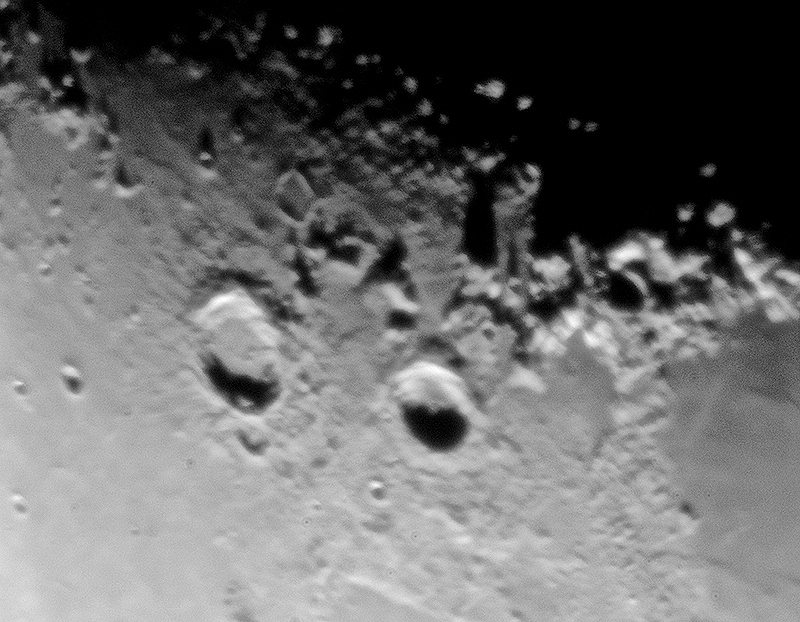
D7000 DSLR Imaging: Moon, Venus, ISS, Spica Spectrum, 5 Galaxies
Posted: 28 April 2012
Opened the observatory Friday, 27 April, at 1828 MST, 85°F. I had four main purposes for this session: make another attempt at imaging the International Space Station (ISS), resume spectra imaging, collimate the 8" LX200-ACF, and re-image four galaxies that were imaged (but not well) on the previous session.
At 1844 MST, viewed Venus, 77X and 206X. Then viewed the moon, 77X and 206X. The central peaks in the Crater Theophilus looked nice again this night. Next, I updated the ISS TLE in the telescope. Shortly after sunset, I did some lunar imaging with the D7000 DSLR. This one was done at prime focus, 1/320sec, ISO 500:

This cropped, Hat Trick, ISO 100, image shows the Crater Theophilus. Compare it to the image from the previous night.

At 1926 MST, I began preparations for imaging the upcoming ISS pass at prime focus. Used the moon to focus, then locked the focus. Slewed to Venus to check the finderscope alignment; tweaked it slightly. I then did a video test recording using Venus, 1/2000sec, ISO 3200, 640x424, 30fps. This is 189 frames from the video, stacked using Keith's Image Stacker, cropped, and upscaled 200%:

The initial pointing on the ISS AOS was way off, but I managed to catch up to the ISS at times and several frames had images of the ISS. Here are four frames from the 5m43s video showing the changing orientation of the space station during the pass:
![]()
At 2015 MST, I viewed Mars at 206X. Seeing was not very good. The North Polar Cap and sunrise cloud were visible. There were hints of some dark areas. I then returned to the moon for more lunar observing at 206X. The views along the terminator were fascinating. The area near the craters Aristoteles and Eudoxus was especially grand. I decided to try to capture the view. This is a cropped, Hat Trick, ISO 400, image:

Then did some more lunar observing at 364X. Viewed two star occultations using 206X. Ended lunar observing at 2130 MST.
My next target was the star Spica to capture its spectra (Spectral Type B1) using the "Star Analyzer". This is the processed image, 1/10sec, ISO 2000:
![]()
At 2200 MST, viewed Saturn at 77X, 133X, and 206X. Four moons were visible: Titan, Rhea, Tethys, and Dione. I then had to swap the rechargeable batteries in the Wireless AutoStar II.
At 2215 MST, I began the collimation process of the 8" LX200-ACF using the technique in this collimation article by Thierry Legault. Below are pre-collimation (left) and post-collimation (right) images of the star Spica, prime focus, 1/30sec, ISO 6400:


The re-collimation was completed at 2257 MST. While not exactly perfect, the recollimated 8" showed marked improvement in the view of Saturn and Mars at 206X. The views were much sharper, with more details visible. I will refine the collimation to get closer to perfect on a future session.
At 2306 MST, I began preparations for DSO imaging. I did my usual focus test on a star using the Bahtinov Mask, did framing test exposures, and looked for suitable guide stars. Available guide stars were not always ideal. Here are the galaxy images I took, all cropped to the same scale, guided, 5 minutes, ISO 6400:
M61:

M88:

M58:

M60 (right) and NGC4647 (left):

Closed the observatory at 0122 MST, 58°F. Another long session in the observatory.
Comments are welcome; use the Comments section below, or you can Email Me. Thanks.
Go to the previous report.
Return to the Cassiopeia Observatory Welcome Page.